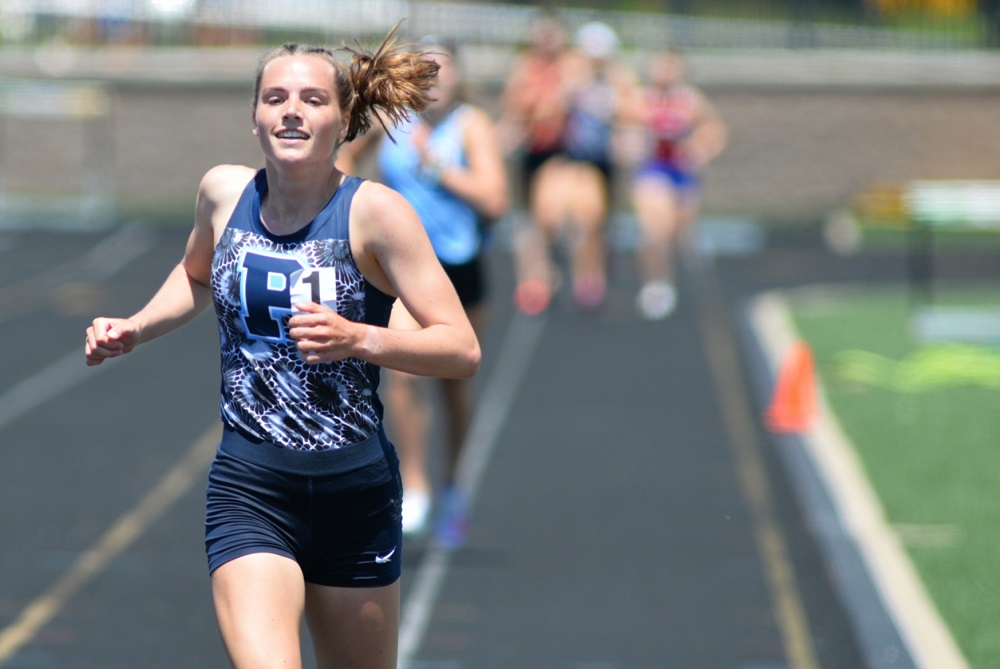
Petoskey Goes Distance Again for 1st Track Finals Win
June 6, 2021
ZEELAND – Petoskey went the distance again Saturday at the Lower Peninsula Division 2 Girls Track & Field Finals.
After claiming the Division 2 cross country championship in the fall, with senior Emma Squires the individual race winner, the Northmen were bolstered by Squires again in winning their first Finals title on the track.
Squires won the 800 (2:14) and 1,600 (4:55.05), finished second in the 3,200 and anchored the winning 3,200 relay (9:27.33) at Zeeland, which added up to 38 of Petoskey’s total 48 points. Parma Western was second with 29.
The Northmen’s only other top-two Finals finish had come in 1992, when they finished Class B runners-up.
“It definitely was a really hot, windy day, definitely not the best conditions, but we just had to gut through it,” Squires said. “It was definitely the hardest race and meet ever this season.
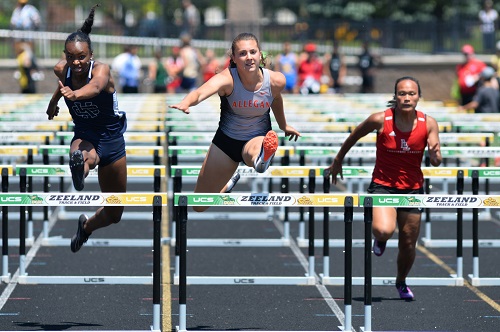 “The past two weeks definitely we’ve all been stressing about it. But we tried to sleep well and eat well and train well, and it definitely worked out well. We all peaked at the right time.”
“The past two weeks definitely we’ve all been stressing about it. But we tried to sleep well and eat well and train well, and it definitely worked out well. We all peaked at the right time.”
Squires was joined the on the 3,200 relay by senior Sarah Liederbach and juniors Noel Vanderwall and Caroline Farley. Vanderwall also joined Squires finishing fourth in the 1,600 and sixth in the 3,200, and Farley was right there with a seventh in the 3,200 as well.
“The distance girls won the state championship in cross country, and that’s where all of our points came from today,” Petoskey coach Karen Starkey said. “Throughout the year they worked hard, and we had some not-so-good weather, but everybody just worked together and it was positive. … They have a lot of guts, desire, and they’re a good group of girls and we’re going to miss them.
“I was pretty confident they would perform (Saturday) as they did all season long. It’s unusual to have goose bumps on an 88-degree day. And that happened several times today.”
Bridgeport junior Chaniya Madison was among those who powered through as well, as she won the 100 (12.36) and 200 (25.96) to score 20 of third-place Bridgeport’s 26 points. She previously had won the 100 as a freshman in 2019. Allegan senior Hannah Antkoviak was another double champ, claiming the titles in the 100 hurdles (14.94) and 300 (44.69).
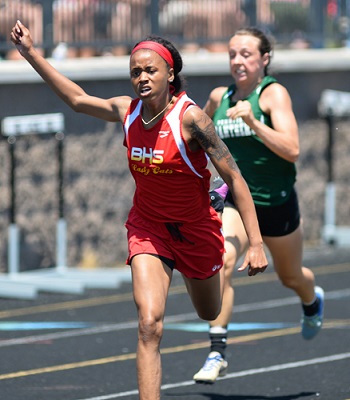 Big Rapids’ senior Erika Beistle also gave a two-title good-bye to her high school career with a 20-foot win in the discus (147-5) while claiming the shot put championship (42-10) as well.
Big Rapids’ senior Erika Beistle also gave a two-title good-bye to her high school career with a 20-foot win in the discus (147-5) while claiming the shot put championship (42-10) as well.
Belding freshman Brook Simpson, meanwhile, debuted by setting the LPD2 meet record in the high jump at 5-10, besting the 5-9 jumps by Sara Jane Baker of Mattawan in 2001 and Christine Krellwitz of Big Rapids in 2004.
Bloomfield Hills Cranbrook Kingswood senior Kaya Freeman won the long jump (17-4), and Grand Rapids West Catholic senior Katie Clifford won the pole vault (12-0). Simpson also finished second in the 400 to Marysville junior Reese Powers, who crossed first in that race in 57.71 seconds. Linden won the 400 relay (50.36), Hudsonville Unity Christian won the 800 relay (1:47.14) and Dearborn Divine Child won the 1,600 relay (4:04.32).
PHOTOS: (Top) Petoskey’s Emma Squires outpaces the field during one of her championship runs Saturday at Zeeland. (Middle) Allegan’s Hannah Antkoviak, middle, works to stay just ahead of Cranbrook’s Kaya Freeman (left) and Stevensville Lakeshore’s Lynea Slayback. (Below) Bridgeport’s Chaniya Madison powers through the final strides of one of her sprint victories. (Photos by Dave McCauley/RunMichigan.com.)
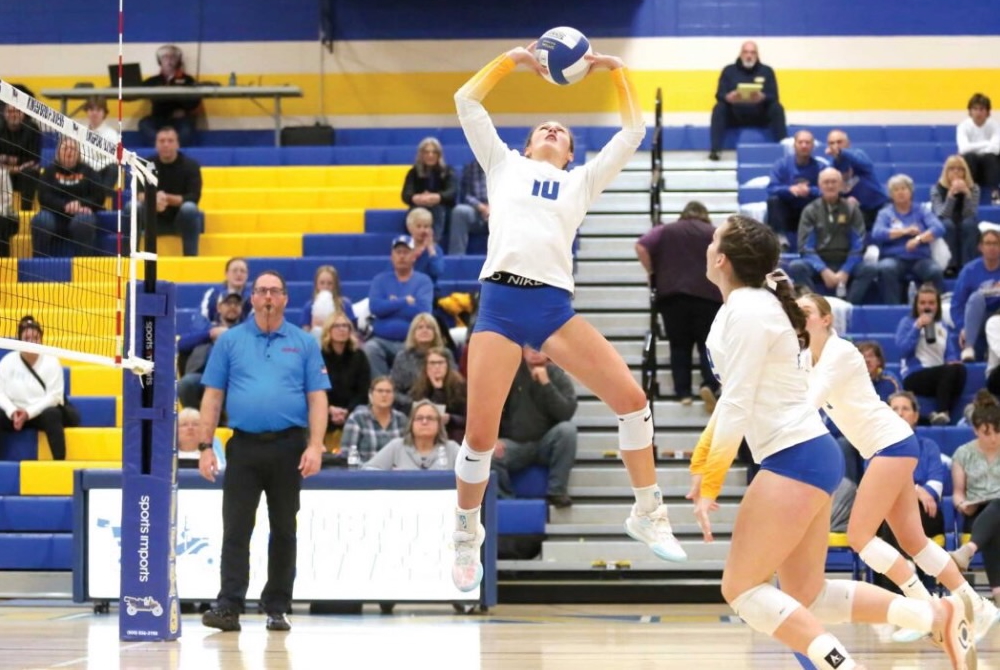
Kingsford's Kreider Prepared for Next Level After Finishing Stellar Flivvers Career
By
John Vrancic
Special for MHSAA.com
June 19, 2025
KINGSFORD — After completing a successful high school volleyball career, Maddy Kreider is ready to take the next step.
 The Kingsford senior is taking her talents to Michigan Tech, where she’s expected to continue primarily as a setter.
The Kingsford senior is taking her talents to Michigan Tech, where she’s expected to continue primarily as a setter.
“That will be a big step for sure, but it’ll be exciting being with the girls,” she said. “The girls are taller in college. It will definitely be an adjustment, physically and mentally. We’ll be traveling longer distances, and it’ll be a matter of improving the mental part of my game.”
Kreider was selected the Upper Peninsula’s Defensive Player of the Year her final two seasons after the U.P. Sportswriters and Sportscasters Association began voting for all-U.P. volleyball.
“That’s quite an accomplishment,” she said. “It’s a real honor playing with girls I grew up with. We had a great season.”
The 5-foot-8 setter was a four-year starter and two-year team captain at Kingsford, leading the Flivvers to three Division 2 District titles and back-to-back undefeated Great Northern Conference championships. She twice was named GNC Player of the Year.
She was also selected all-state first team in the fall and all-state second team in 2023, and all-region throughout her prep career. Her serving percentage also topped .900 throughout her four seasons on varsity.
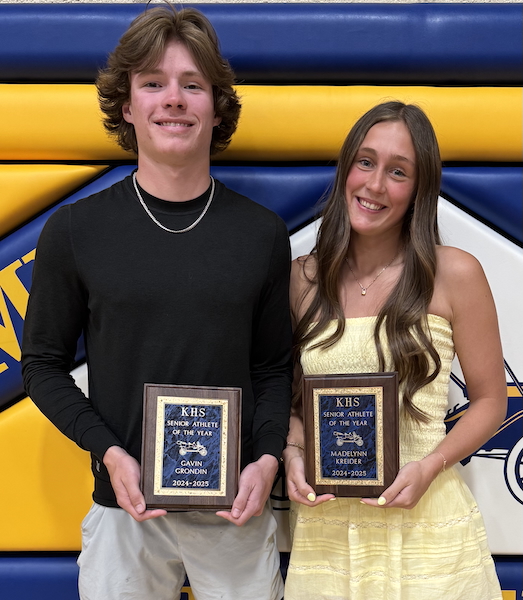 Last fall, the Flivvers reached the Regional Semifinal at Manistique where they dropped a 3-2 decision to Kingsley.
Last fall, the Flivvers reached the Regional Semifinal at Manistique where they dropped a 3-2 decision to Kingsley.
“I thought we’d get through,” Kreider said. “We came out lights out in the first two sets, then it was close in the last three.”
Also among the team’s highlights this past fall was a victory at Calumet, approximately 2½ weeks after dropping a 3-1 decision to the Copper Kings on Kingsford’s home floor.
“We wanted to play them,” Kreider said. “They’re a great bunch of girls to play against. They’ve been the measuring stick up here for many years. Winning on their floor was super exciting. We knew we had to play well just to be competitive. That was a great confidence builder for our group. We were definitely on a high going into the District.”
The Flivvers opened their postseason with a 3-1 triumph over Houghton, then defeated Escanaba in straight sets in the District Final.
Kreider will join Calumet senior Maddie Torola at MTU this fall. Torola, who recorded a season-high 19 kills in the four-set victory at Kingsford, helped the Copper Kings finish 29-5 and reach the Division 3 Regional Final at Sault Ste. Marie where they dropped a 3-2 decision to Traverse City St. Francis.
“It was fun playing against her in high school,” Kreider said. “It will be even more fun playing as teammates. It’ll be exciting to be playing on the same team.”
Both will be playing under new head coach Cindy Pindral at Tech. Both of Kreider’s parents played for the Huskies, her mother (and Kingsford varsity coach) Jaclynn volleyball from 1998-2002 and her father Jason basketball from 1997-2000.
Maddy Kreider recently earned an additional honor when she was selected Female Athlete of the Year for Kingsford’s Class of 2025. She recently completed a solid track & field season for the Flivvers.
At the U.P. Division 1 Finals, Kreider placed fourth in the 100-meter dash (13.2) and anchored the Flivvers to a third-place finish in the 800 relay (1:51.57) and fourth in the 400 (53.03) on their home track.
Kreider was named one of 32 MHSAA/Farm Bureau Insurance Scholar-Athlete Award winners this winter and plans to study exercise science and kinesiology at MTU.
 John Vrancic has covered high school sports in the Upper Peninsula since joining the Escanaba Daily Press staff in 1985. He is known most prominently across the peninsula for his extensive coverage of cross country and track & field that frequently appears in newspapers from the Wisconsin border to Lake Huron. He received the James Trethewey Award for Distinguished Service in 2015 from the Upper Peninsula Sportswriters and Sportscasters Association.
John Vrancic has covered high school sports in the Upper Peninsula since joining the Escanaba Daily Press staff in 1985. He is known most prominently across the peninsula for his extensive coverage of cross country and track & field that frequently appears in newspapers from the Wisconsin border to Lake Huron. He received the James Trethewey Award for Distinguished Service in 2015 from the Upper Peninsula Sportswriters and Sportscasters Association.
PHOTOS (Top) Kingsford’s Maddy Kreider sets for her teammates during a match last season. (Middle) Kreider, right, takes a photo with Kingsford’s Male Athlete of the Year Gavin Grondin. (Photos provided by the Kingsford athletic department.)

